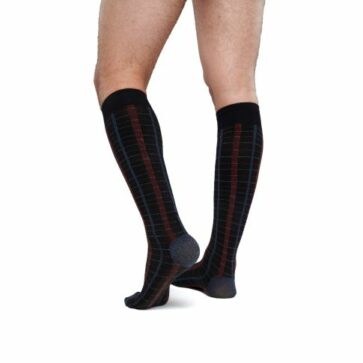Diabetes – A Guide
For people with diabetes, leg problems are common and can easily become serious. This is particularly so if blood sugar levels are not well controlled over a long period of time.
Our simple guide to diabetes gives you a thorough overview of possible leg problems initiated by the condition. You can read about the symptoms of diabetes, the causes of diabetes and treatment for diabetes, including how wearing compression hosiery can help living with diabetes more comfortable for you.
For Diabetes, Daylong recommends:
If you have diabetes you are more prone to developing poor circulation. This means you may not notice when your have a minor injury, such as a cut, abrasion or insect bite. This can lead to infection, which may develop into a foot or leg ulcer. Around 10% of people with diabetes develop an infected foot or leg ulcers at some point, which can be painful and take a long time to heal.
The symptoms of diabetes include leg problems such as:
- Swollen lower legs with constant aching and pain
- Feet and lower legs often feel unusually warm to the touch
- Damp skin due to excess sweating
- Skin texture changes, becoming cracked and dry
- Open sores and ulcers can develop on the toes, feet or ankles
How to treat leg problems
Successful treatment for diabetes-related leg problems usually involves several different treatment approaches. Prevention is very important. Every complication of diabetes is lowered if you can control your blood sugar by using your medication and watching your weight, what you eat, and how much you exercise.
Leg problems are mostly due to problems with the blood vessels in the legs. These can be helped by wearing compression stockings.
A recent study has shown that light compression – between 18 and 25 mmHg – can decrease leg and foot swelling, without any adverse effect on circulation. Compression hosiery must always be used under the direction of a doctor as it can prove harmful if you have underlying arterial disease.
What causes leg problems with Diabetes?
High blood sugar can lead to damage to the blood vessels throughout the body, and also affects the peripheral nerves. This combination can lead to poor circulation and a loss of sensation in the feet and lower legs, making leg ulcers more likely. Other issues include:
- Blocked arteries: Arteries in the legs are damaged due to exposure to large amounts of glucose in the blood. This leads to atherosclerosis in the arteries that supply the lower legs and feet, which causes the tissues to suffer from lack of oxygen, creating the condition known as ischaemia.
- Poor circulation: Capillaries are also prone to damage, and respond by thickening their walls. This makes it more difficult for oxygen to pass out into the tissues, which worsens the ischaemia.
- Peripheral neuropathy: This is damage to the nerves in the legs and feet, which makes it more likely that damage from shoes that rub, insect bites and bumps and knocks will go untreated, leading to infection and a foot or leg ulcer.
Top tips to protect your legs if you have Diabetes
People with diabetes are only too aware of the problems the disease can cause. These simple steps can help make living with diabetes more comfortable:
- Foot and leg care is very important. Get into the habit of checking your feet every day for minor injuries. Keep them clean, and use any treatments for leg ulcers that your doctor prescribes.
- Control your diabetes. This means monitoring your blood sugar levels and ensuring your insulin levels are good. Always lookout for the latest advice from your doctor on how to stay as healthy as possible.
- Wear compression hosiery. If you need to wear compression hosiery, make sure it’s made to measure and that you know how to wear it properly. Our guide to compression will help.




